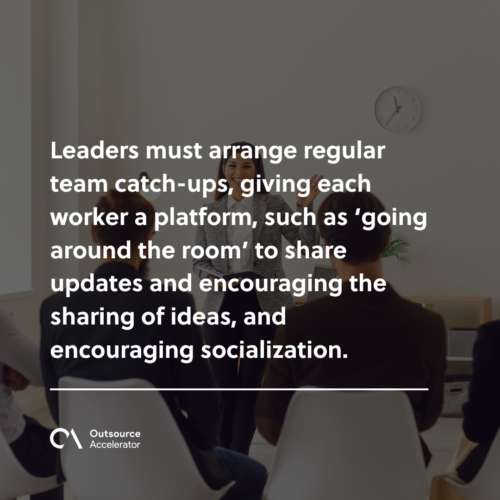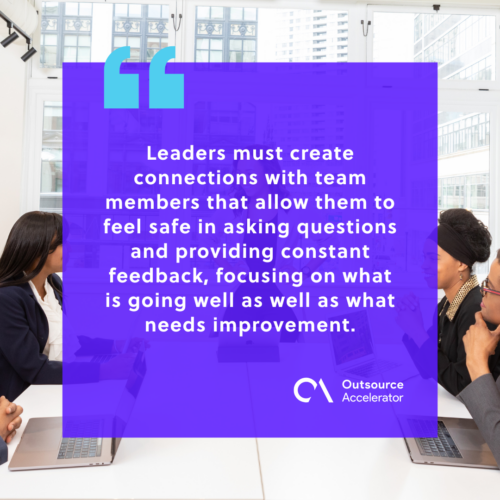OUTspoken: Bright ideas from outsourcing leaders. This article is authored by Infinit-o for the OUTspoken series
COVID-19 has changed many elements of our personal and professional lives; some things may never revert to the way they were, even after the pandemic eventually abates. For leaders, navigating achieving operational excellence in any extended crisis is challenging. When the crisis has profoundly affected working methods, this challenge becomes even greater.
This article covers some examples of effective ways I have seen leaders motivate and engage their teams in these difficult times.
Renewed focus on communication
How we communicate at work has changed immeasurably in the last year or so. For leaders, it is critical to ensure agility in communication, as well as understand how different employees might be coping with new and unusual communication processes.
One of the largest changes is the quick transition to remote working. It has brought plenty of advantages to the workplace, but employees can often struggle with the lack of social contact and direction, and leaders have had to find new and effective ways of communicating with their teams.
One of the keys to ensuring a high level of engagement and motivation in a remote or socially distant environment is to over-communicate.
Leaders must arrange regular team catch-ups, giving each worker a platform, such as ‘going around the room’ to share updates and encouraging the sharing of ideas, and encouraging socialization. Leaders have set up small project teams and increased the frequency of one-to-one meetings with an increased focus on the welfare of the team members. These have been essential to ensure that leaders can keep up with developments and that employees get the contact they need.

Understanding that everyone reacts differently to a crisis
The pandemic has, in many ways, been a very individual experience. Some people, unaffected by illness and enjoying working at home, have had a good year. Other people have experienced mental illness, financial hardship, or bereavement.
When motivating the team and interacting with them, leaders must acknowledge that peoples’ experiences, thoughts, and feelings will all be very idiosyncratic, depending on who they are and what has happened.
A handy model to keep in mind is the Kübler-Ross Change Curve, which plots out how individuals react to change. Leaders can reference this curve when having one-to-ones with their teams, using empathy and emotional intelligence to consider where on the curve the person might be sitting; for example, are they in denial or are they accepting what has happened?
Tools like this are enabling leaders to consider action plans and motivational strategies going forward. The challenge is that leaders will often need to follow multiple paths to achieve engagement across several team members, which can take time and resources to accomplish.
Offering people structure and containment
Leaders have a responsibility to manage and where possible, alleviate people’s anxiety to COVID-19, as well as working to ensure tasks are completed and operational excellence is
achieved.
One of the key ways to motivate staff in times of change is offer structure and containment to allow the team to feel that there is a support network in place that will allow them to perform at their best.
Offering structure is achieved through many ways, for example through the setting of clear goals and normalising hierarchies, even if this is only temporary. Leaders should keep all processes under review, never promise a return to old ways of working (as we do not know if this will ever come!) and as part of the ‘overcommunication’ strategy, encourage brainstorming and idea sharing to drive the operation forward, rewarding and recognising success as needed.
Seeking feedback
Gelling all these motivation and engagement tools together is critical for leaders to succeed, but they need to go further. They need to constantly reflect on how things are going and be vulnerable to their team, allowing for themselves to be emotionally exposed to uncertainty, risk, and emotions.
COVID-19 is partly characterised by its unpredictable nature; restrictions and business requirements can change from one day to the next. Team members are not just looking for the answers but also their leaders’ vulnerability.
Leaders must create connections with team members that allow them to feel safe in asking questions and providing constant feedback, focusing on what is going well as well as what needs improvement.
For a leader, being courageous and hearing such feedback can be challenging but in any evolving situation, it will be critical for success.

In pursuit of excellence
Leaders should not view COVID-19 as a reason to ease off the throttle in the strive for operational excellence: in many ways, improving the business is more important now than ever before. Critical to this success is looking after team members who have been through a lot since the pandemic surfaced in March 2020.
Critical to this new people strategy is the appreciation that leaders play an even more important role in the engagement of their team members. A nuanced approach is needed with more time being dedicated to flexibly navigating the new leadership priorities and tailoring your style as the old one-size-fits-all approach to leadership no longer works.
Leaders who are vulnerable, agile enough to change for the better, communicate in new ways and keep an ear to the ground to see how things are going will ensure that they and their businesses are setting themselves up for success in whatever the future brings.

 Independent
Independent





















